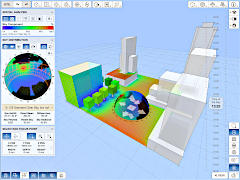SHADING ANALYSIS
Site Designer

This web app extends my dynamic daylighting tool to bring shading, solar radiation and view analysis to the level of an entire site rather than just a single room. It uses the same framework and infrastructure as the daylight tool, but with some more interesting snapping, editing and model generation functions. This means that it uses the same block-optimised ray-tracing routines, so the geometry is still limited to axially-aligned rectilinear blocks. However, I have added an experimental constructive solid geometry (CSG) model to automatically merge intersecting blocks into more complex shapes so that the intersecting edges are not shown. Another distinguishing feature is the ability to add multiple analysis grids, both flat and volumetric, and to automatically fit them to selected surfaces or volumes.
Comparing Solar Position Data
I have had a couple of occasions recently where I needed to directly compare different solar position algorithms, as well as predicted versus recorded position data. This sounds pretty simple, but there are actually some interesting little quirks where even datasets that are so close as to be virtually identical will still throw up spuriously large differences in individual values. I thought these might be worth documenting and discussing.
Why Shading Calculations Take so Long
Calculating detailed solar shading and overshadowing is a problem for most building analysis tools, ECOTECT included. It is important to a whole range of building performance criteria, from thermal and daylighting analysis through to solar access and rights-to-light. However, doing it fully and properly can take a frustratingly long time. This article explains exactly what is happening during these calculations and offers tips on how to optimise the process and make best use of your existing shading data.
Solar Shading Potential
Not all parts of a solar shading device are equally effective or even necessary. Techniques have been developed in ECOTECT to visually map variations in effectiveness over the actual geometry of a modelled shading device. These same techniques can be used during the design process to map shading potential over a proposed device or even to determine the best location for shading. This article explains the concepts behind these techniques and how they may be best applied.
An Optimised Shading Example
A number of people have recently requested information on how to complete an overshadowing exercise I set some Masters students at a couple of different Universities. As a result, I have added some more descriptive text and reformatted the original answer sheet to describe both the exercise problem and an example method that can be used to generate the answer.
Domes and Solar Radiation
Domed roofs have great structural advantages, but also some significant thermal advantages due to their response to incident solar radiation. This article presents a quick outline of this response when compared to flat or inclined roofs and why it may be desirable.